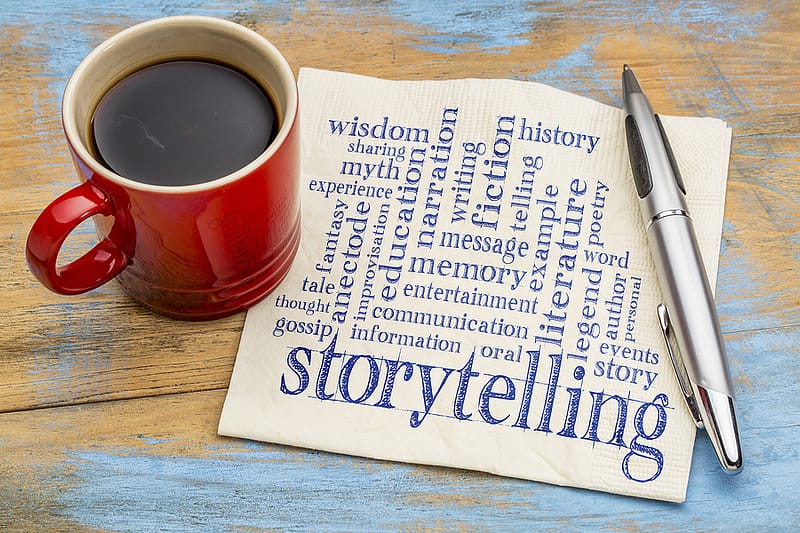Connect with your customers through storytelling
People love a good story. Stories can inspire us, bring us to tears, fuel our imagination, and help us feel closer to the person telling the story. Content marketing is about telling a good story. When I hear a good story I feel connected somehow to that person or business, especially if it resonates with my own stories or beliefs.
Storytelling is not new. I remember a road trip to Arizona many years ago where we stopped off at a restaurant for lunch. As we waited for our sandwiches, we noticed an older gentleman with a small audience telling stories around a fire pit in an area behind the restaurant. It was perfect timing for our meandering road trip. We sat there for hours listening to his stories of Native American history in the area. Needless to say, we didn’t get far on our journey that day and ended up camping nearby for the evening filled with wonder from the stories we had heard.
But what does all that have to do with marketing?

Great question....
A good story can be a powerful tool for businesses, content marketing tells compelling stories. Personal stories that are authentic are obviously the best ones. People know when you are making a story up and not being authentic or sincere, so find those stories, even if they don’t blow people’s minds, and tell them. A great business story leaves your audience with a connection, they can see themselves in the story, or maybe or see a friend or relative. Maybe they had a similar experience and can relate.
Stanford Women’s Leadership Innovation Lab says that stories are remembered up to 22 times more than facts alone. “When people think of advocating for their ideas, they think of convincing arguments based on data, facts, and figures. However, studies show that if you share a story, people are often more likely to be persuaded.”
When you tell a business story it should have a clear outcome
Nike has always told great stories in their branding, as have Apple and Disney.
- Who is telling the story?
- Why is the story being told, what is the problem?
- When and where is the story taking place?
- Who are the people in the story?
- What are they trying to achieve?
- What challenges did they face and what was the outcome of the story?
The African Market Baskets Story
One of our eCommerce clients sells Bloga baskets from Africa and I love their story. It connects them to the people that are making the baskets, back to the people who are purchasing them. Their story is a simple but heartwarming story and it lets their own customers know they are part of a bigger cause.
Steve the owner truly believes in giving back. When he started his wholesale basket company, African Market Baskets, he visited the Bolga area of Africa and soon realized that the weavers had many needs. While weaving brought work to the villages, many weavers were working in the hot sun and didn’t have their basic needs met.
He started a non-profit called Every Basket Helps™ which is funded by 10% of the sales of the baskets. With that money they have been able to provide basic school supplies for the weavers’ children, mosquito nets to help prevent malaria, health care for families, and a building to be out of the sun and rains. His story is a compelling story that makes his customers feel good buying from him rather than another company and make them feel connected to the product.
His story is told on his website in many areas, including his photo galleries, and more compelling in his video gallery. Their story is not just about selling baskets, but rather solving a problem. His company sells baskets, but his story is about how he has helped more than 400 weavers have a better life.
Maybe your story is not quite so altruistic, but it is still your story or the story of your customers. Stories have the ability to create connections with you and your customers. With connection comes trust and your stories help you stand out from your competition.


Key elements that help make a great story
Be relatable – make the story about something your customers can relate to, know your audience, and tell those stories that will resonate with them. If you are talking about yourself or your employees make it so that there is a connection. I love how Kristin, at this Oregon wine country bed and breakfast has photos of her team on her about page. These are the people you are interacting with at the business and a short story about them with a photo immediately makes you feel a connection.
Identify a problem – What problems or obstacles have you helped your customers overcome? How have you helped them out and what was the outcome? Is it a story other customers can identify with? Document the journey in your story of how you solved a customer’s problem or helped them have an amazing experience with your company.
More story ideas:
- Why did you start your business?
- Are you carrying on a family legacy?
- What did you envision when you started your business?
- What challenges were you facing or did you face as a result of starting it?
Adding video or photos to your story also helps it stay front of mind for the reader.
In conclusion, stories are a great way to let people know who they are doing business with.
Do you have a story you could share with your customers that you think would resonate with them? I bet you do, and I’m sure your audience would love to read it.
Here is my story. Let us know if you need help writing your story, or would like us to review your story for feedback.